-
 McCarthy Album 06, Photograph 245
McCarthy Album 06, Photograph 245 No Caption. Grace and William McCarthy with unidentified young woman, standing on a hillside under a large tree, at an unidentified location, c. 1920.
-
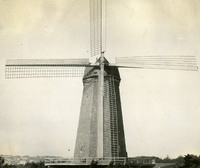 McCarthy Album 06, Photograph 244
McCarthy Album 06, Photograph 244 No Caption. A Dutch Windmill, at unidentified location, likely at San Francisco's Golden Gate Park, c. 1910.
-
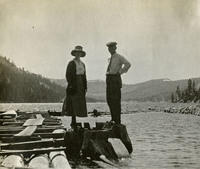 McCarthy Album 06, Photograph 243
McCarthy Album 06, Photograph 243 No Caption. Grace and William McCarthy standing on a tree stump near a dock at an unidentified location, c. 1920.
-
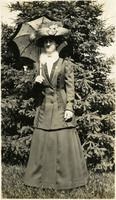 McCarthy Album 06, Photograph 242
McCarthy Album 06, Photograph 242 No Caption. Grace McCarthy posing for a photograph in front of a pine tree, c. 1908.
-
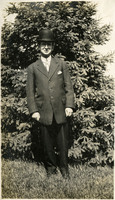 McCarthy Album 06, Photograph 241
McCarthy Album 06, Photograph 241 No Caption. William McCarthy posing for a photograph in front of a pine tree, c. 1908.
-
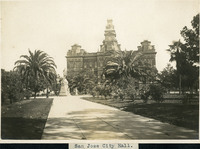 McCarthy Album 06, Photograph 240
McCarthy Album 06, Photograph 240 Caption: "San Jose City Hall," c. 1905, (Theodore Lenzen, Architect), was built in 1889 with a budget of $150,000. The brick and terracotta structure was demolished and replaced in 1958.
-
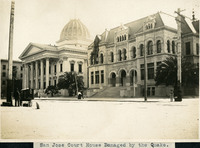 McCarthy Album 06, Photograph 239
McCarthy Album 06, Photograph 239 Caption: "San Jose Court House Damaged by the Quake," c. 1906. A view of the San Jose Courthouse (left), and Hall of Records, which sustained some damage seen along the roofline, as a result of the 1906 San Francisco earthquake
-
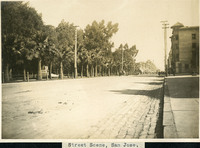 McCarthy Album 06, Photograph 238
McCarthy Album 06, Photograph 238 Caption: "Street Scene, San Jose," c. 1910. A horse-drawn carriage and several pedestrians can be seen in the distance along a palm-lined street in San Jose.
-
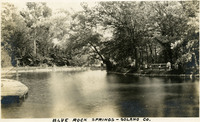 McCarthy Album 06, Photograph 237
McCarthy Album 06, Photograph 237 Caption: "Blue Rock Springs - Solano Co." c. 1915. In the 1860s, White Sulphur Springs (in the vicinity of Vallejo) was developed for use as a mineral springs resort, featuring a hotel, several cottages, and an "amusement" building with a dance floor, bar, and billiard room. Manuel Madrid obtained the property around the turn of the twentieth century, and changed the name to Blue Rock Springs. The area is now managed by the Greater Vallejo Recreation District as Blue Rock Springs Park.
-
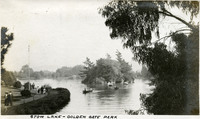 McCarthy Album 06, Photograph 236
McCarthy Album 06, Photograph 236 Caption: "Stow Lake, G.G. Park," c.1910. Stow Lake is a man-made lake in Golden Gate Park dating back to 1893. Visitors still enjoy Stow Lake today, engaging in activities such as boating and picnicking by the lake.
-
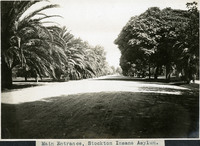 McCarthy Album 06, Photograph 235
McCarthy Album 06, Photograph 235 Caption: "Main Entrance, Stockton Insane Asylum," c. 1906. The Stockton Insane Asylum was established in 1851, completed in 1853, and was the first public mental health hospital in California. It remained a functioning state hospital until 1995.
-
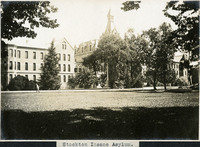 McCarthy Album 06, Photograph 234
McCarthy Album 06, Photograph 234 Caption: "Stockton Insane Asylum," c. 1906. The Stockton Insane Asylum was established in 1851, completed in 1853, and was the first public mental health hospital in California. It remained a functioning state hospital until 1995.
-
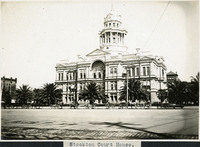 McCarthy Album 06, Photograph 233
McCarthy Album 06, Photograph 233 Caption: "Stockton Court House," c. 1906, (E.E. Meyers, Architect). San Joaquin County Courthouse, Stockton, California. The neo-classical building was completed in 1890 and demolished in 1961 to may way for a new courthouse.
-
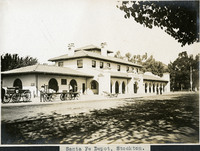 McCarthy Album 06, Photograph 232
McCarthy Album 06, Photograph 232 Caption: "Santa Fe Depot, Stockton," c. 1906. The Santa Fe Depot (William Benson Storey, architect) was completed in 1899 for the Atchison, Topeka, and Santa Fe Railway. Added to the National Register of Historic Places in 1976, the depot was renovated and restored it to its original design, and reopened in 2005.
-
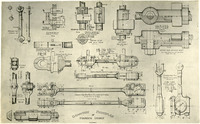 McCarthy Album 06, Photograph 231
McCarthy Album 06, Photograph 231 Caption: "Elementary Principles of Machine Design, WM McCarthy," (William McCarthy, Illustrator).
-
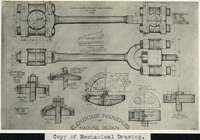 McCarthy Album 06, Photograph 230
McCarthy Album 06, Photograph 230 Caption: "Copy of Mechanical drawing," illustrator unknown, but likely William McCarthy.
-
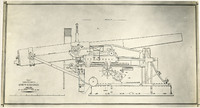 McCarthy Album 06, Photograph 229
McCarthy Album 06, Photograph 229 Caption: "U.S. 10" Disappearing Gun & Carriage, Model 1896, Wm McCarthy, July 20, 1905."
-
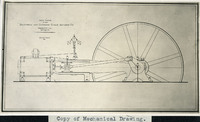 McCarthy Album 06, Photograph 228
McCarthy Album 06, Photograph 228 Caption: "Copy of Mechanical Drawing," (William McCarthy, Artist). A drawing of the main engine of the California and Hawaiian Sugar Refining Co. in Crockett, California.
-
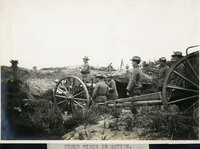 McCarthy Album 06, Photograph 227
McCarthy Album 06, Photograph 227 Caption: "Field Piece in Action." Unidentified location, c. 1905-1915. Shows a crew of men operating a 3" field gun, a heavy artillery gun set onto a carriage for mobile use. The U.S. military used these guns between 1905 and 1919, gradually phasing them out of use during the 1920s in favor of more modern weapons.
-
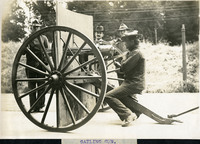 McCarthy Album 06, Photograph 226
McCarthy Album 06, Photograph 226 Caption: "Gatling gun," c. 1905. three unidentified men and William McCarthy (third from right) stand near a Gatling gun. The Gatling gun was an early rapid-fire, crank-turned weapon first used during combat in the Civil War. Developed in 1861 by Dr. Richard J. Gatling, the weapon was commonly used during the late nineteenth century before being superseded by newer, more modern guns.
-
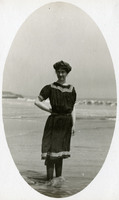 McCarthy Album 06, Photograph 225
McCarthy Album 06, Photograph 225 No caption: Grace McCarthy in a swimsuit at an unidentified location, c. 1910.
-
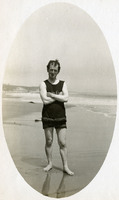 McCarthy Album 06, Photograph 224
McCarthy Album 06, Photograph 224 No caption. William McCarthy in a swimsuit at an unidentified location, c. 1910.
-
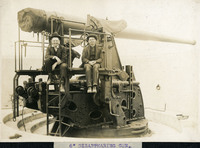 McCarthy Album 06, Photograph 223
McCarthy Album 06, Photograph 223 Caption: "6" Disappearing Gun." Two unidentified men sit on a 6" disappearing gun at an unidentified location. The disappearing guns were coastal artillery pieces installed to defend major American seaports, primarily during the first half of the twentieth century.
-
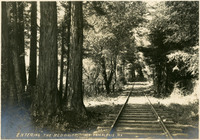 McCarthy Album 06, Photograph 222
McCarthy Album 06, Photograph 222 Caption: "Entering The Redwoods, Mt Tamalpais RR," c. 1907. A view of the Muir Woods Railway tracks, established in 1896 as a scenic tourist railway between Mill Valley and the east peak of Mount Tamalpais in Marin County.
-
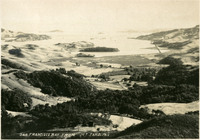 McCarthy Album 06, Photograph 221
McCarthy Album 06, Photograph 221 Caption: "San Francisco Bay From Mt Tamalpais," c. 1907. A bird's eye view of the bay from atop Mount Tamalpais.
-
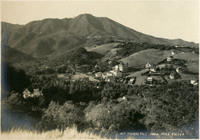 McCarthy Album 06, Photograph 220
McCarthy Album 06, Photograph 220 Caption: "Mt Tamalpais from Mill Valley," c. 1907 shows a bird's eye view of Mount Tamalpais and the valley below.
-
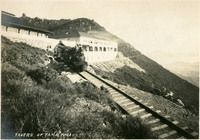 McCarthy Album 06, Photograph 219
McCarthy Album 06, Photograph 219 Caption: "Tavern of Tamalpais," c. 1907, shows a train leaving the Tamalpais Tavern on Mount Tamalpais in Marin County.
-
 McCarthy Album 06, Photograph 219.0
McCarthy Album 06, Photograph 219.0 Caption: "Tamalpais Views." A label in album 6 referring to photographs 218-222.
-
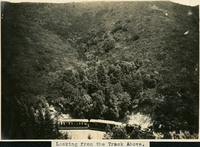 McCarthy Album 06, Photograph 218
McCarthy Album 06, Photograph 218 Caption: "Looking from the Track Above," c. 1907. A view of a train engine and two cars taken from above at Mount Tamalpais.
-
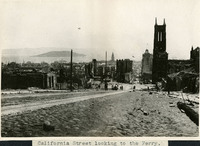 McCarthy Album 06, Photograph 217
McCarthy Album 06, Photograph 217 Caption: "California Street looking to the Ferry," 1906. A view of the destruction along California street after the earthquake and fire.
-
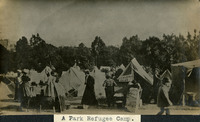 McCarthy Album 06, Photograph 216
McCarthy Album 06, Photograph 216 Caption: "A Park Refugee Camp," c. 1906. After the earthquake and fire that destroyed much of San Francisco in April 1906, hundreds of thousands of people were left homeless. Many of these people established temporary refugee camps, using tents or debris from the destruction to cobble together shelters.
-
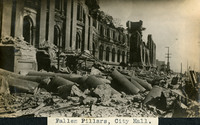 McCarthy Album 06, Photograph 215
McCarthy Album 06, Photograph 215 Caption: "Fallen Pillars, City Hall," shows the pillars of San Francisco City Hall that fell into the street as a result of the 1906 earthquake.
-
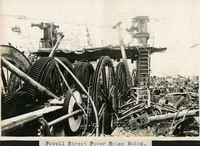 McCarthy Album 06, Photograph 214
McCarthy Album 06, Photograph 214 Caption: "Powell Street Power House Ruins," shows a view of the Powell Street power house in complete disarray after the 1906 earthquake.
-
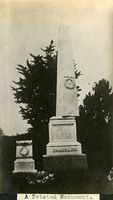 McCarthy Album 06, Photograph 213
McCarthy Album 06, Photograph 213 Caption: "A Twisted Monument," 1906, shows damage from the earthquake to a monument in a San Francisco cemetery.
-
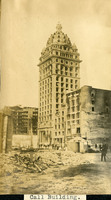 McCarthy Album 06, Photograph 212
McCarthy Album 06, Photograph 212 Caption: "Call Building," c. 1906. Completed in 1898 and designed by civic leader Claus Spreckels, the Call building on the corner of 3rd and Market streets was one of the first skyscrapers in San Francisco, built to house the San Francisco Call newspaper offices. While the structure withstood the 1906 earthquake, the interior caught fire and sustained considerable damage. After major renovations, the building is today known as The Central Tower.
-
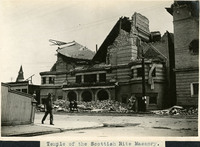 McCarthy Album 06, Photograph 211
McCarthy Album 06, Photograph 211 Caption: "Temple of the Scottish Rite Masonry," 1906. The Temple of the Scottish Rite Masonry shows heavy damage from the earthquake and fires.
-
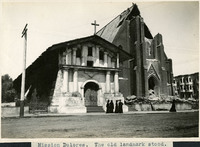 McCarthy Album 06, Photograph 210
McCarthy Album 06, Photograph 210 Caption: "Mission Dolores. The old landmark stood," 1906. Mission Delores, the oldest intact building still standing in San Francisco today, suffered little damage from the 1906 earthquake. The parish church next to it was greatly damaged and rebuilt as the Mission Dolores Basilica, opened in 1918.
-
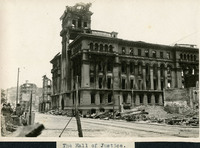 McCarthy Album 06, Photograph 209
McCarthy Album 06, Photograph 209 Caption: "The Hall of Justice," c. 1906. A view of the Hall of Justice in San Francisco shows the building's utter destruction after the 1906 earthquake and fire.
-
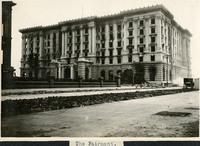 McCarthy Album 06, Photograph 208
McCarthy Album 06, Photograph 208 Caption: "The Fairmont," c. 1906. View of the Fairmont Hotel, a luxury hotel in San Francisco. Although construction was mostly finished in 1906, the advent of the San Francisco earthquake and fire of that year damaged the hotel's interior and delayed opening until 1907. It was the first hotel in what is now the Fairmont Hotels and Resorts chain. In 1945, the San Francisco hotel was host to an international conference that culminated in the formation of the United Nations.
-
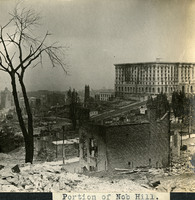 McCarthy Album 06, Photograph 207
McCarthy Album 06, Photograph 207 Caption: "Portion of Nob Hill," c. 1906. A portion of Nob Hill, with the Fairmont Hotel on the right side of the photograph, reveals the destruction from the 1906 earthquake and fires.
-
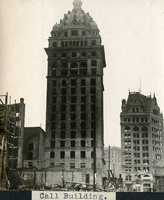 McCarthy Album 06, Photograph 206
McCarthy Album 06, Photograph 206 Caption: "Call Building," c. 1906. The remains of the Call building after the 1906 earthquake and fire. Completed in 1898 and designed by civic leader Claus Spreckels, the Call building on the corner of 3rd and Market streets was one of the first skyscrapers in San Francisco, built to house the San Francisco Call newspaper offices. While the structure withstood the 1906 earthquake, the interior caught fire and sustained considerable damage. After major renovations, the building is today known as The Central Tower.
-
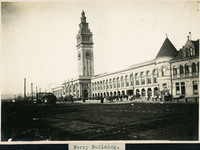 McCarthy Album 06, Photograph 205
McCarthy Album 06, Photograph 205 Caption: "Ferry Building," c. 1907. A view of the San Francisco Ferry Building (A. Page Brown, architect) during repairs from the 1906 earthquake. The Beaux Arts structure is located on San Francisco's Embarcadero and features a 245 foot tall clock tower, with four clock dials, each 22 feet in diameter.
-
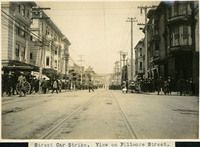 McCarthy Album 06, Photograph 204
McCarthy Album 06, Photograph 204 Caption: "Street Car Strike," c. 1907. San Francisco's street car union workers called for a strike after their request to be paid three dollars per eight- hour work day was declined. At the start of the strike, two strikers were shot by strike breakers and many more causalities were reported. Hundreds of passengers were injured during the strike due to inexperienced operators, and twenty-five of those passengers died as a result. In total, the upheaval resulted in thirty-one causalities.
-
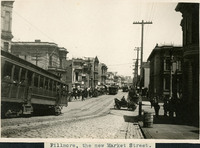 McCarthy Album 06, Photograph 203
McCarthy Album 06, Photograph 203 Caption: "Fillmore, the new Market Street," c. 1907. A view of a busy Fillmore Street indicating that much of the city's business has moved from Market Street during reconstruction after the earthquake.
-
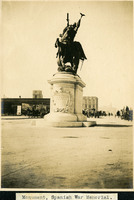 McCarthy Album 06, Photograph 202
McCarthy Album 06, Photograph 202 Caption: "Monument, Spanish War Memorial," 1906. A view of the Spanish-American War Memorial in San Francisco.
-
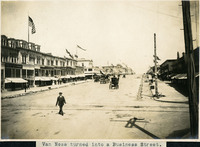 McCarthy Album 06, Photograph 201
McCarthy Album 06, Photograph 201 Caption: "Van Ness turned into a Business Street." c.1906
-
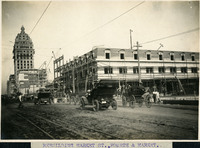 McCarthy Album 06, Photograph 200
McCarthy Album 06, Photograph 200 Caption: "Rebuilding Market St., Fourth & Market," c.1906. A view of the rebuilding efforts on Market Street after the 1906 earthquake.
-
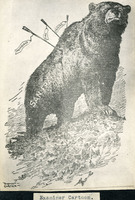 McCarthy Album 06, Photograph 199
McCarthy Album 06, Photograph 199 Caption: "Examiner Cartoon" (Robert Caster, Cartoonist) c. 1906. A rendering of a giant and fierce grizzly bear labeled with "San Francisco" on its side, standing on a hillside, with three arrows in its hide, tagged with the words: "Earthquake," "Fire," and "Famine.," with the word "Undaunted!" above.
-
 McCarthy Album 06, Photograph 197
McCarthy Album 06, Photograph 197 Caption: "Building up on Market Street," c. 1907. A view of Market Street repairs one year after the 1906 earthquake and fires.
-
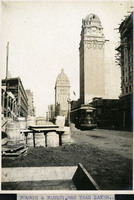 McCarthy Album 06, Photograph 196
McCarthy Album 06, Photograph 196 Caption: "Fourth and Market, One Year Later," 1907, shows much construction in progress, and completed, to the street and buildings one year after the 1906 earthquake and fires.
 McCarthy Album 06, Photograph 245 No Caption. Grace and William McCarthy with unidentified young woman, standing on a hillside under a large tree, at an unidentified location, c. 1920.
McCarthy Album 06, Photograph 245 No Caption. Grace and William McCarthy with unidentified young woman, standing on a hillside under a large tree, at an unidentified location, c. 1920. McCarthy Album 06, Photograph 244 No Caption. A Dutch Windmill, at unidentified location, likely at San Francisco's Golden Gate Park, c. 1910.
McCarthy Album 06, Photograph 244 No Caption. A Dutch Windmill, at unidentified location, likely at San Francisco's Golden Gate Park, c. 1910. McCarthy Album 06, Photograph 243 No Caption. Grace and William McCarthy standing on a tree stump near a dock at an unidentified location, c. 1920.
McCarthy Album 06, Photograph 243 No Caption. Grace and William McCarthy standing on a tree stump near a dock at an unidentified location, c. 1920. McCarthy Album 06, Photograph 242 No Caption. Grace McCarthy posing for a photograph in front of a pine tree, c. 1908.
McCarthy Album 06, Photograph 242 No Caption. Grace McCarthy posing for a photograph in front of a pine tree, c. 1908. McCarthy Album 06, Photograph 241 No Caption. William McCarthy posing for a photograph in front of a pine tree, c. 1908.
McCarthy Album 06, Photograph 241 No Caption. William McCarthy posing for a photograph in front of a pine tree, c. 1908. McCarthy Album 06, Photograph 240 Caption: "San Jose City Hall," c. 1905, (Theodore Lenzen, Architect), was built in 1889 with a budget of $150,000. The brick and terracotta structure was demolished and replaced in 1958.
McCarthy Album 06, Photograph 240 Caption: "San Jose City Hall," c. 1905, (Theodore Lenzen, Architect), was built in 1889 with a budget of $150,000. The brick and terracotta structure was demolished and replaced in 1958. McCarthy Album 06, Photograph 239 Caption: "San Jose Court House Damaged by the Quake," c. 1906. A view of the San Jose Courthouse (left), and Hall of Records, which sustained some damage seen along the roofline, as a result of the 1906 San Francisco earthquake
McCarthy Album 06, Photograph 239 Caption: "San Jose Court House Damaged by the Quake," c. 1906. A view of the San Jose Courthouse (left), and Hall of Records, which sustained some damage seen along the roofline, as a result of the 1906 San Francisco earthquake McCarthy Album 06, Photograph 238 Caption: "Street Scene, San Jose," c. 1910. A horse-drawn carriage and several pedestrians can be seen in the distance along a palm-lined street in San Jose.
McCarthy Album 06, Photograph 238 Caption: "Street Scene, San Jose," c. 1910. A horse-drawn carriage and several pedestrians can be seen in the distance along a palm-lined street in San Jose. McCarthy Album 06, Photograph 237 Caption: "Blue Rock Springs - Solano Co." c. 1915. In the 1860s, White Sulphur Springs (in the vicinity of Vallejo) was developed for use as a mineral springs resort, featuring a hotel, several cottages, and an "amusement" building with a dance floor, bar, and billiard room. Manuel Madrid obtained the property around the turn of the twentieth century, and changed the name to Blue Rock Springs. The area is now managed by the Greater Vallejo Recreation District as Blue Rock Springs Park.
McCarthy Album 06, Photograph 237 Caption: "Blue Rock Springs - Solano Co." c. 1915. In the 1860s, White Sulphur Springs (in the vicinity of Vallejo) was developed for use as a mineral springs resort, featuring a hotel, several cottages, and an "amusement" building with a dance floor, bar, and billiard room. Manuel Madrid obtained the property around the turn of the twentieth century, and changed the name to Blue Rock Springs. The area is now managed by the Greater Vallejo Recreation District as Blue Rock Springs Park. McCarthy Album 06, Photograph 236 Caption: "Stow Lake, G.G. Park," c.1910. Stow Lake is a man-made lake in Golden Gate Park dating back to 1893. Visitors still enjoy Stow Lake today, engaging in activities such as boating and picnicking by the lake.
McCarthy Album 06, Photograph 236 Caption: "Stow Lake, G.G. Park," c.1910. Stow Lake is a man-made lake in Golden Gate Park dating back to 1893. Visitors still enjoy Stow Lake today, engaging in activities such as boating and picnicking by the lake. McCarthy Album 06, Photograph 235 Caption: "Main Entrance, Stockton Insane Asylum," c. 1906. The Stockton Insane Asylum was established in 1851, completed in 1853, and was the first public mental health hospital in California. It remained a functioning state hospital until 1995.
McCarthy Album 06, Photograph 235 Caption: "Main Entrance, Stockton Insane Asylum," c. 1906. The Stockton Insane Asylum was established in 1851, completed in 1853, and was the first public mental health hospital in California. It remained a functioning state hospital until 1995. McCarthy Album 06, Photograph 234 Caption: "Stockton Insane Asylum," c. 1906. The Stockton Insane Asylum was established in 1851, completed in 1853, and was the first public mental health hospital in California. It remained a functioning state hospital until 1995.
McCarthy Album 06, Photograph 234 Caption: "Stockton Insane Asylum," c. 1906. The Stockton Insane Asylum was established in 1851, completed in 1853, and was the first public mental health hospital in California. It remained a functioning state hospital until 1995. McCarthy Album 06, Photograph 233 Caption: "Stockton Court House," c. 1906, (E.E. Meyers, Architect). San Joaquin County Courthouse, Stockton, California. The neo-classical building was completed in 1890 and demolished in 1961 to may way for a new courthouse.
McCarthy Album 06, Photograph 233 Caption: "Stockton Court House," c. 1906, (E.E. Meyers, Architect). San Joaquin County Courthouse, Stockton, California. The neo-classical building was completed in 1890 and demolished in 1961 to may way for a new courthouse. McCarthy Album 06, Photograph 232 Caption: "Santa Fe Depot, Stockton," c. 1906. The Santa Fe Depot (William Benson Storey, architect) was completed in 1899 for the Atchison, Topeka, and Santa Fe Railway. Added to the National Register of Historic Places in 1976, the depot was renovated and restored it to its original design, and reopened in 2005.
McCarthy Album 06, Photograph 232 Caption: "Santa Fe Depot, Stockton," c. 1906. The Santa Fe Depot (William Benson Storey, architect) was completed in 1899 for the Atchison, Topeka, and Santa Fe Railway. Added to the National Register of Historic Places in 1976, the depot was renovated and restored it to its original design, and reopened in 2005. McCarthy Album 06, Photograph 231 Caption: "Elementary Principles of Machine Design, WM McCarthy," (William McCarthy, Illustrator).
McCarthy Album 06, Photograph 231 Caption: "Elementary Principles of Machine Design, WM McCarthy," (William McCarthy, Illustrator). McCarthy Album 06, Photograph 230 Caption: "Copy of Mechanical drawing," illustrator unknown, but likely William McCarthy.
McCarthy Album 06, Photograph 230 Caption: "Copy of Mechanical drawing," illustrator unknown, but likely William McCarthy. McCarthy Album 06, Photograph 229 Caption: "U.S. 10" Disappearing Gun & Carriage, Model 1896, Wm McCarthy, July 20, 1905."
McCarthy Album 06, Photograph 229 Caption: "U.S. 10" Disappearing Gun & Carriage, Model 1896, Wm McCarthy, July 20, 1905." McCarthy Album 06, Photograph 228 Caption: "Copy of Mechanical Drawing," (William McCarthy, Artist). A drawing of the main engine of the California and Hawaiian Sugar Refining Co. in Crockett, California.
McCarthy Album 06, Photograph 228 Caption: "Copy of Mechanical Drawing," (William McCarthy, Artist). A drawing of the main engine of the California and Hawaiian Sugar Refining Co. in Crockett, California. McCarthy Album 06, Photograph 227 Caption: "Field Piece in Action." Unidentified location, c. 1905-1915. Shows a crew of men operating a 3" field gun, a heavy artillery gun set onto a carriage for mobile use. The U.S. military used these guns between 1905 and 1919, gradually phasing them out of use during the 1920s in favor of more modern weapons.
McCarthy Album 06, Photograph 227 Caption: "Field Piece in Action." Unidentified location, c. 1905-1915. Shows a crew of men operating a 3" field gun, a heavy artillery gun set onto a carriage for mobile use. The U.S. military used these guns between 1905 and 1919, gradually phasing them out of use during the 1920s in favor of more modern weapons. McCarthy Album 06, Photograph 226 Caption: "Gatling gun," c. 1905. three unidentified men and William McCarthy (third from right) stand near a Gatling gun. The Gatling gun was an early rapid-fire, crank-turned weapon first used during combat in the Civil War. Developed in 1861 by Dr. Richard J. Gatling, the weapon was commonly used during the late nineteenth century before being superseded by newer, more modern guns.
McCarthy Album 06, Photograph 226 Caption: "Gatling gun," c. 1905. three unidentified men and William McCarthy (third from right) stand near a Gatling gun. The Gatling gun was an early rapid-fire, crank-turned weapon first used during combat in the Civil War. Developed in 1861 by Dr. Richard J. Gatling, the weapon was commonly used during the late nineteenth century before being superseded by newer, more modern guns. McCarthy Album 06, Photograph 225 No caption: Grace McCarthy in a swimsuit at an unidentified location, c. 1910.
McCarthy Album 06, Photograph 225 No caption: Grace McCarthy in a swimsuit at an unidentified location, c. 1910. McCarthy Album 06, Photograph 224 No caption. William McCarthy in a swimsuit at an unidentified location, c. 1910.
McCarthy Album 06, Photograph 224 No caption. William McCarthy in a swimsuit at an unidentified location, c. 1910. McCarthy Album 06, Photograph 223 Caption: "6" Disappearing Gun." Two unidentified men sit on a 6" disappearing gun at an unidentified location. The disappearing guns were coastal artillery pieces installed to defend major American seaports, primarily during the first half of the twentieth century.
McCarthy Album 06, Photograph 223 Caption: "6" Disappearing Gun." Two unidentified men sit on a 6" disappearing gun at an unidentified location. The disappearing guns were coastal artillery pieces installed to defend major American seaports, primarily during the first half of the twentieth century. McCarthy Album 06, Photograph 222 Caption: "Entering The Redwoods, Mt Tamalpais RR," c. 1907. A view of the Muir Woods Railway tracks, established in 1896 as a scenic tourist railway between Mill Valley and the east peak of Mount Tamalpais in Marin County.
McCarthy Album 06, Photograph 222 Caption: "Entering The Redwoods, Mt Tamalpais RR," c. 1907. A view of the Muir Woods Railway tracks, established in 1896 as a scenic tourist railway between Mill Valley and the east peak of Mount Tamalpais in Marin County. McCarthy Album 06, Photograph 221 Caption: "San Francisco Bay From Mt Tamalpais," c. 1907. A bird's eye view of the bay from atop Mount Tamalpais.
McCarthy Album 06, Photograph 221 Caption: "San Francisco Bay From Mt Tamalpais," c. 1907. A bird's eye view of the bay from atop Mount Tamalpais. McCarthy Album 06, Photograph 220 Caption: "Mt Tamalpais from Mill Valley," c. 1907 shows a bird's eye view of Mount Tamalpais and the valley below.
McCarthy Album 06, Photograph 220 Caption: "Mt Tamalpais from Mill Valley," c. 1907 shows a bird's eye view of Mount Tamalpais and the valley below. McCarthy Album 06, Photograph 219 Caption: "Tavern of Tamalpais," c. 1907, shows a train leaving the Tamalpais Tavern on Mount Tamalpais in Marin County.
McCarthy Album 06, Photograph 219 Caption: "Tavern of Tamalpais," c. 1907, shows a train leaving the Tamalpais Tavern on Mount Tamalpais in Marin County. McCarthy Album 06, Photograph 219.0 Caption: "Tamalpais Views." A label in album 6 referring to photographs 218-222.
McCarthy Album 06, Photograph 219.0 Caption: "Tamalpais Views." A label in album 6 referring to photographs 218-222. McCarthy Album 06, Photograph 218 Caption: "Looking from the Track Above," c. 1907. A view of a train engine and two cars taken from above at Mount Tamalpais.
McCarthy Album 06, Photograph 218 Caption: "Looking from the Track Above," c. 1907. A view of a train engine and two cars taken from above at Mount Tamalpais. McCarthy Album 06, Photograph 217 Caption: "California Street looking to the Ferry," 1906. A view of the destruction along California street after the earthquake and fire.
McCarthy Album 06, Photograph 217 Caption: "California Street looking to the Ferry," 1906. A view of the destruction along California street after the earthquake and fire. McCarthy Album 06, Photograph 216 Caption: "A Park Refugee Camp," c. 1906. After the earthquake and fire that destroyed much of San Francisco in April 1906, hundreds of thousands of people were left homeless. Many of these people established temporary refugee camps, using tents or debris from the destruction to cobble together shelters.
McCarthy Album 06, Photograph 216 Caption: "A Park Refugee Camp," c. 1906. After the earthquake and fire that destroyed much of San Francisco in April 1906, hundreds of thousands of people were left homeless. Many of these people established temporary refugee camps, using tents or debris from the destruction to cobble together shelters. McCarthy Album 06, Photograph 215 Caption: "Fallen Pillars, City Hall," shows the pillars of San Francisco City Hall that fell into the street as a result of the 1906 earthquake.
McCarthy Album 06, Photograph 215 Caption: "Fallen Pillars, City Hall," shows the pillars of San Francisco City Hall that fell into the street as a result of the 1906 earthquake. McCarthy Album 06, Photograph 214 Caption: "Powell Street Power House Ruins," shows a view of the Powell Street power house in complete disarray after the 1906 earthquake.
McCarthy Album 06, Photograph 214 Caption: "Powell Street Power House Ruins," shows a view of the Powell Street power house in complete disarray after the 1906 earthquake. McCarthy Album 06, Photograph 213 Caption: "A Twisted Monument," 1906, shows damage from the earthquake to a monument in a San Francisco cemetery.
McCarthy Album 06, Photograph 213 Caption: "A Twisted Monument," 1906, shows damage from the earthquake to a monument in a San Francisco cemetery. McCarthy Album 06, Photograph 212 Caption: "Call Building," c. 1906. Completed in 1898 and designed by civic leader Claus Spreckels, the Call building on the corner of 3rd and Market streets was one of the first skyscrapers in San Francisco, built to house the San Francisco Call newspaper offices. While the structure withstood the 1906 earthquake, the interior caught fire and sustained considerable damage. After major renovations, the building is today known as The Central Tower.
McCarthy Album 06, Photograph 212 Caption: "Call Building," c. 1906. Completed in 1898 and designed by civic leader Claus Spreckels, the Call building on the corner of 3rd and Market streets was one of the first skyscrapers in San Francisco, built to house the San Francisco Call newspaper offices. While the structure withstood the 1906 earthquake, the interior caught fire and sustained considerable damage. After major renovations, the building is today known as The Central Tower. McCarthy Album 06, Photograph 211 Caption: "Temple of the Scottish Rite Masonry," 1906. The Temple of the Scottish Rite Masonry shows heavy damage from the earthquake and fires.
McCarthy Album 06, Photograph 211 Caption: "Temple of the Scottish Rite Masonry," 1906. The Temple of the Scottish Rite Masonry shows heavy damage from the earthquake and fires. McCarthy Album 06, Photograph 210 Caption: "Mission Dolores. The old landmark stood," 1906. Mission Delores, the oldest intact building still standing in San Francisco today, suffered little damage from the 1906 earthquake. The parish church next to it was greatly damaged and rebuilt as the Mission Dolores Basilica, opened in 1918.
McCarthy Album 06, Photograph 210 Caption: "Mission Dolores. The old landmark stood," 1906. Mission Delores, the oldest intact building still standing in San Francisco today, suffered little damage from the 1906 earthquake. The parish church next to it was greatly damaged and rebuilt as the Mission Dolores Basilica, opened in 1918. McCarthy Album 06, Photograph 209 Caption: "The Hall of Justice," c. 1906. A view of the Hall of Justice in San Francisco shows the building's utter destruction after the 1906 earthquake and fire.
McCarthy Album 06, Photograph 209 Caption: "The Hall of Justice," c. 1906. A view of the Hall of Justice in San Francisco shows the building's utter destruction after the 1906 earthquake and fire. McCarthy Album 06, Photograph 208 Caption: "The Fairmont," c. 1906. View of the Fairmont Hotel, a luxury hotel in San Francisco. Although construction was mostly finished in 1906, the advent of the San Francisco earthquake and fire of that year damaged the hotel's interior and delayed opening until 1907. It was the first hotel in what is now the Fairmont Hotels and Resorts chain. In 1945, the San Francisco hotel was host to an international conference that culminated in the formation of the United Nations.
McCarthy Album 06, Photograph 208 Caption: "The Fairmont," c. 1906. View of the Fairmont Hotel, a luxury hotel in San Francisco. Although construction was mostly finished in 1906, the advent of the San Francisco earthquake and fire of that year damaged the hotel's interior and delayed opening until 1907. It was the first hotel in what is now the Fairmont Hotels and Resorts chain. In 1945, the San Francisco hotel was host to an international conference that culminated in the formation of the United Nations. McCarthy Album 06, Photograph 207 Caption: "Portion of Nob Hill," c. 1906. A portion of Nob Hill, with the Fairmont Hotel on the right side of the photograph, reveals the destruction from the 1906 earthquake and fires.
McCarthy Album 06, Photograph 207 Caption: "Portion of Nob Hill," c. 1906. A portion of Nob Hill, with the Fairmont Hotel on the right side of the photograph, reveals the destruction from the 1906 earthquake and fires. McCarthy Album 06, Photograph 206 Caption: "Call Building," c. 1906. The remains of the Call building after the 1906 earthquake and fire. Completed in 1898 and designed by civic leader Claus Spreckels, the Call building on the corner of 3rd and Market streets was one of the first skyscrapers in San Francisco, built to house the San Francisco Call newspaper offices. While the structure withstood the 1906 earthquake, the interior caught fire and sustained considerable damage. After major renovations, the building is today known as The Central Tower.
McCarthy Album 06, Photograph 206 Caption: "Call Building," c. 1906. The remains of the Call building after the 1906 earthquake and fire. Completed in 1898 and designed by civic leader Claus Spreckels, the Call building on the corner of 3rd and Market streets was one of the first skyscrapers in San Francisco, built to house the San Francisco Call newspaper offices. While the structure withstood the 1906 earthquake, the interior caught fire and sustained considerable damage. After major renovations, the building is today known as The Central Tower. McCarthy Album 06, Photograph 205 Caption: "Ferry Building," c. 1907. A view of the San Francisco Ferry Building (A. Page Brown, architect) during repairs from the 1906 earthquake. The Beaux Arts structure is located on San Francisco's Embarcadero and features a 245 foot tall clock tower, with four clock dials, each 22 feet in diameter.
McCarthy Album 06, Photograph 205 Caption: "Ferry Building," c. 1907. A view of the San Francisco Ferry Building (A. Page Brown, architect) during repairs from the 1906 earthquake. The Beaux Arts structure is located on San Francisco's Embarcadero and features a 245 foot tall clock tower, with four clock dials, each 22 feet in diameter. McCarthy Album 06, Photograph 204 Caption: "Street Car Strike," c. 1907. San Francisco's street car union workers called for a strike after their request to be paid three dollars per eight- hour work day was declined. At the start of the strike, two strikers were shot by strike breakers and many more causalities were reported. Hundreds of passengers were injured during the strike due to inexperienced operators, and twenty-five of those passengers died as a result. In total, the upheaval resulted in thirty-one causalities.
McCarthy Album 06, Photograph 204 Caption: "Street Car Strike," c. 1907. San Francisco's street car union workers called for a strike after their request to be paid three dollars per eight- hour work day was declined. At the start of the strike, two strikers were shot by strike breakers and many more causalities were reported. Hundreds of passengers were injured during the strike due to inexperienced operators, and twenty-five of those passengers died as a result. In total, the upheaval resulted in thirty-one causalities. McCarthy Album 06, Photograph 203 Caption: "Fillmore, the new Market Street," c. 1907. A view of a busy Fillmore Street indicating that much of the city's business has moved from Market Street during reconstruction after the earthquake.
McCarthy Album 06, Photograph 203 Caption: "Fillmore, the new Market Street," c. 1907. A view of a busy Fillmore Street indicating that much of the city's business has moved from Market Street during reconstruction after the earthquake. McCarthy Album 06, Photograph 202 Caption: "Monument, Spanish War Memorial," 1906. A view of the Spanish-American War Memorial in San Francisco.
McCarthy Album 06, Photograph 202 Caption: "Monument, Spanish War Memorial," 1906. A view of the Spanish-American War Memorial in San Francisco. McCarthy Album 06, Photograph 201 Caption: "Van Ness turned into a Business Street." c.1906
McCarthy Album 06, Photograph 201 Caption: "Van Ness turned into a Business Street." c.1906 McCarthy Album 06, Photograph 200 Caption: "Rebuilding Market St., Fourth & Market," c.1906. A view of the rebuilding efforts on Market Street after the 1906 earthquake.
McCarthy Album 06, Photograph 200 Caption: "Rebuilding Market St., Fourth & Market," c.1906. A view of the rebuilding efforts on Market Street after the 1906 earthquake. McCarthy Album 06, Photograph 199 Caption: "Examiner Cartoon" (Robert Caster, Cartoonist) c. 1906. A rendering of a giant and fierce grizzly bear labeled with "San Francisco" on its side, standing on a hillside, with three arrows in its hide, tagged with the words: "Earthquake," "Fire," and "Famine.," with the word "Undaunted!" above.
McCarthy Album 06, Photograph 199 Caption: "Examiner Cartoon" (Robert Caster, Cartoonist) c. 1906. A rendering of a giant and fierce grizzly bear labeled with "San Francisco" on its side, standing on a hillside, with three arrows in its hide, tagged with the words: "Earthquake," "Fire," and "Famine.," with the word "Undaunted!" above. McCarthy Album 06, Photograph 197 Caption: "Building up on Market Street," c. 1907. A view of Market Street repairs one year after the 1906 earthquake and fires.
McCarthy Album 06, Photograph 197 Caption: "Building up on Market Street," c. 1907. A view of Market Street repairs one year after the 1906 earthquake and fires. McCarthy Album 06, Photograph 196 Caption: "Fourth and Market, One Year Later," 1907, shows much construction in progress, and completed, to the street and buildings one year after the 1906 earthquake and fires.
McCarthy Album 06, Photograph 196 Caption: "Fourth and Market, One Year Later," 1907, shows much construction in progress, and completed, to the street and buildings one year after the 1906 earthquake and fires.